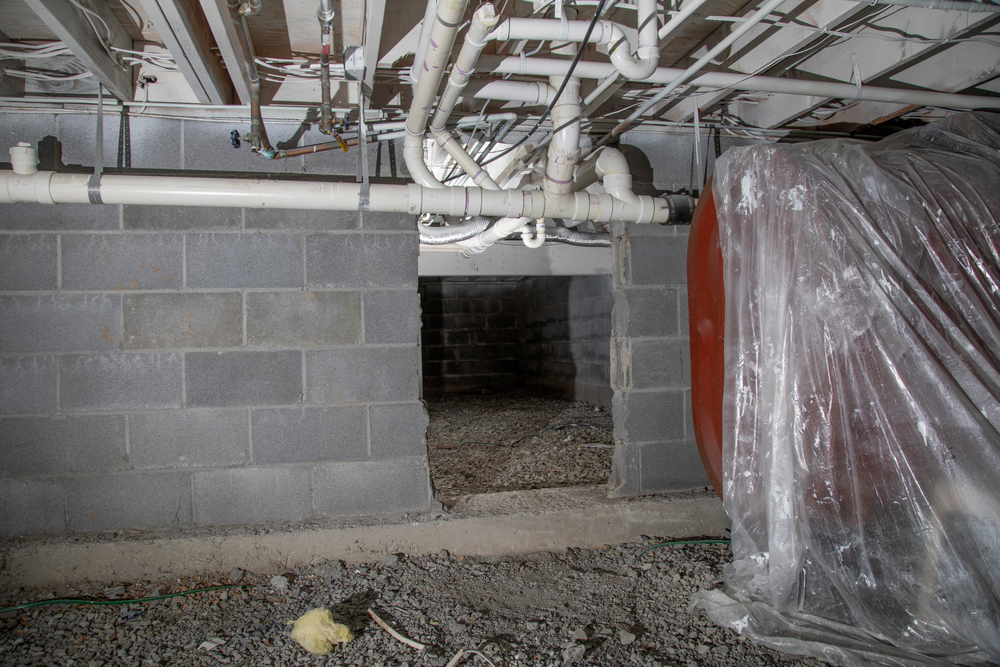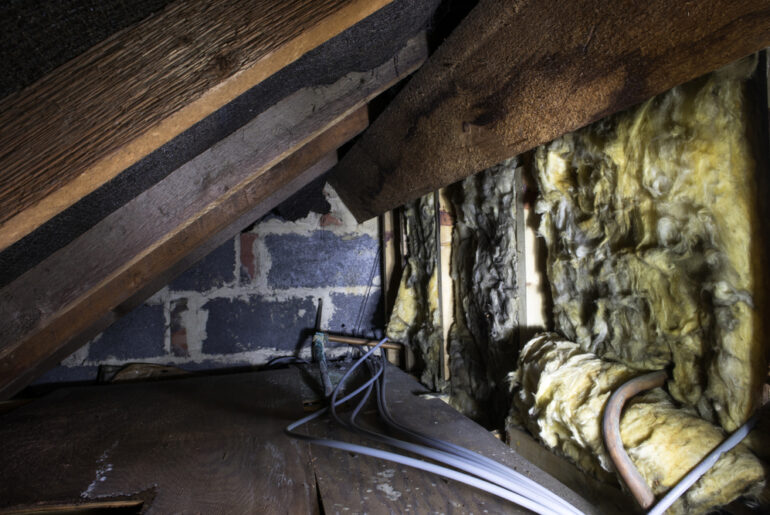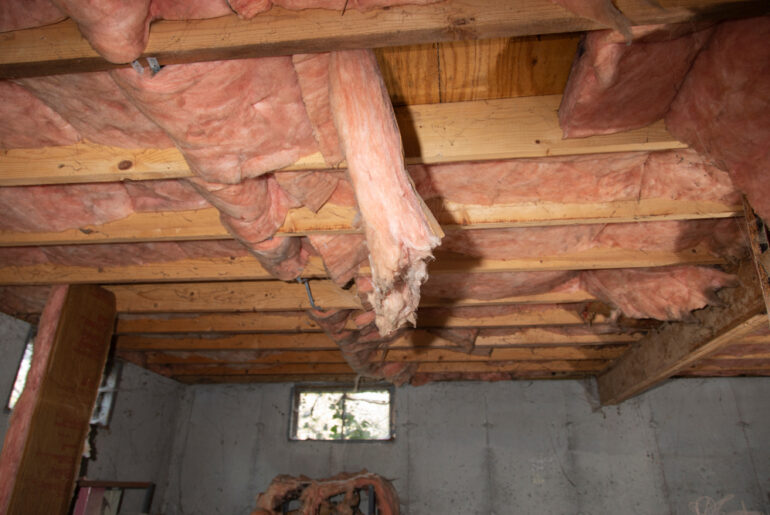Nowadays, there are many types of materials to use for encapsulation around your home. However, each type has its own advantages and disadvantages, so it’s essential to select the best one depending on your needs.
One of the most popular encapsulation materials is spray foam, often used to insulate crawl spaces. But is this the best option? Below, we answer your question.
What Is a Crawl Space Encapsulation?
Crawl space encapsulation refers to the process of sealing off your crawl space with a vapor barrier to prevent moisture, pests, and other elements from entering.
It is often done by covering the floor and walls with a sheet of polyethylene, which is a durable and moisture-resistant material. The primary purpose of crawl space encapsulation is to create a barrier between the outside environment and your home, which can improve indoor air quality and prevent mold growth.
You can use various materials to encapsulate your crawl space, but spray foam is one of the most popular options.
Do note that encapsulation is not the same as insulation. While the former is meant to create a barrier, the latter is designed to regulate temperature by providing insulation.
Thus, you can encapsulate your crawl space without insulating it, but you cannot insulate your crawl space without encapsulating it. When you insulate a space, you’re limiting heat loss or gain. When you encapsulate a space, you’re creating a barrier to keep elements out.
It’s also essential to understand how an encapsulated space differs from a vented or conditioned space. A vented space is open to the outdoors, while a conditioned space is one that is closed off from the outdoors and has its HVAC system.
An encapsulated space is somewhere in between, as it is closed off from the outdoors but does not have its own HVAC system.
Pros of Crawl Space Encapsulation
- Helps to improve indoor air quality
- Reduces the risk of mold growth
- Prevents pests and other critters from entering your home
- Keeps out moisture
- Makes your home more energy-efficient
Cons of Crawl Space Encapsulation
- Can be expensive
- May require professional help
Can You Use Spray Foam To Encapsulate the Crawl Space?
While it’s possible to use spray foam to encapsulate a crawl space, it’s not always the best option. Before choosing this method, there are a few things to consider, including the type of foundation, the climate, and the size of the space.
Foundation
One of the first things to consider is the type of foundation your home has. If you have a concrete foundation, it’s typically best to use a different encapsulation method, such as a vapor barrier.
This is because concrete can absorb moisture, leading to mold and mildew growth. If you have a dirt floor, spray foam may be a good option.
Climate
Another thing to consider is the climate in your area. If you live in an area with high humidity, spray foam can trap moisture in the crawl space. It ultimately results in mold and mildew problems.
That’s why you have to consider whether spray foam will be ideal for your situation or not.
Size
The size of your crawl space is also an essential factor to consider. If the space is tiny, you may be able to get away with using spray foam. However, a larger space may require you to combine spray foam with another method, such as fiberglass.
Typically, spray foam crawl space encapsulation should have a minimum thickness of 3.5. Fortunately, spray foam can last for 80 to 100 years, so once it’s installed, you won’t have to worry about it for a long time.
Do note that if you plan to get a mortgage, you’d have trouble finding lenders who agree to spray foam encapsulation. Sealing the roof space with spray foam restricts air circulation to the timbers and the roof.
It results in condensation, eventually rotting the wooden supports in the roof. As a result, you must have a well-ventilated roof. If you plan to use this method, consult with a professional first to see if it’s the best option for your home.
Plus, you need to ensure you do not use spray foam crawl space encapsulation in the following places:
- Areas close to electrical boxes
- Areas close to ceiling light boxes
- Closed-cavity spaces
- Roof
Spray foam may also be detrimental to your health, especially if you are pregnant, have asthma, or have other respiratory problems. If you insist on using it, be sure to wear a respirator and gloves.
While there are some drawbacks to using spray foam to encapsulate your crawl space, it can be an effective way to prevent moisture and pests from entering the space. For best results, you can use another material, such as cellulose or mineral wood, in conjunction with spray foam.
For instance, you can use cellulose or fiberglass in closed-cavity spaces while using spray foam to seal the rim joists. It will provide you with an extra layer of protection against moisture and pests while still allowing your crawl space to breathe.
What’s The Best Way To Encapsulate Crawl Space?
The way you encapsulate your crawl space with spray foam will depend on different factors. Let’s consider a few scenarios.
Scenario 1: High Humidity and Wood Floors
Suppose you live in an area with high humidity, and your home has wood floors. In this case, you want to ensure that the space is completely isolated from the outdoors.
The first step is to install a thick plastic vapor barrier on the ground. You’ll want to ensure that the barrier covers the entire floor and extends up the walls. Next, install a layer of rigid foam encapsulation on the walls.
It will help to isolate the space further and prevent moisture from seeping in. Finally, install a layer of spray foam encapsulation to create a tight seal that will prevent any moisture from penetrating the space.
Scenario 2: Low Humidity and Concrete Floors
Concrete floors typically don’t require as much encapsulation as wood floors. In this case, you can install a thin layer of plastic on the ground and a layer of spray foam on the walls.
Scenario 3: Unfinished Basement
If you have an unfinished basement, you can still encapsulate the space to create a more comfortable environment. For example, install a layer of spray foam on the walls and ceiling.
Plus, seal any cracks or gaps that may allow moisture or conditioned air to escape.
Scenario 4: Crawl Space with a Dirt Floor
A dirt floor is one of the most challenging types of floors to encapsulate. Therefore, a vapor barrier is a must. Install a thick plastic vapor barrier on the ground and extend it up the walls.
Follow it with a layer of rigid foam encapsulation on the walls. Finally, install a layer of spray foam encapsulation on top of the rigid foam.
When planning to spray foam crawl space encapsulation, make sure you use the right kind of product for your home. For example, if you have an older home with a dirt crawl space, use a product like Poly-Armor to create a barrier between the dirt and your living space.





